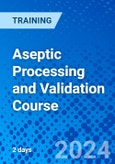This course will provide an overview of the requirements for aseptic and bulk manufacturing operations, including facility design, contamination controls and acceptable personnel behaviors.
Cleanroom classifications and the techniques for proper cleaning and disinfection are presented; along with a high-level overview of microbiology in regards to cleanroom environmental monitoring and the associated impact to product and patient health and safety. This course will also review the guidance provided in USP < 1116> to ensure compliance with regulatory expectations are met.
This is a two-day course for people who need to understand the technical fundamentals of aseptic processing or who are responsible for aseptic operations in a lab, pilot or commercial setting. This aseptic training course is ideally suited to management teams, industrial microbiologists, scientists and engineers either with technical or managerial responsibilities in the biotechnology and pharmaceutical industries.
Cleanroom classifications and the techniques for proper cleaning and disinfection are presented; along with a high-level overview of microbiology in regards to cleanroom environmental monitoring and the associated impact to product and patient health and safety. This course will also review the guidance provided in USP < 1116> to ensure compliance with regulatory expectations are met.
This is a two-day course for people who need to understand the technical fundamentals of aseptic processing or who are responsible for aseptic operations in a lab, pilot or commercial setting. This aseptic training course is ideally suited to management teams, industrial microbiologists, scientists and engineers either with technical or managerial responsibilities in the biotechnology and pharmaceutical industries.
AT THE COMPLETION OF THIS COURSE, ATTENDEES WILL BE ABLE TO:
- Explain the difference between Aseptic and Bulk processing
- Understand facility and personnel requirements necessary to maintain microbial control
- Explain basic principles of microbiology and microorganism recovery in relation to cleanroom environmental monitoring (EM) and impact to product
- Understand the gowning requirements associated with different cleanroom classifications
- Explain basic principles of aseptic processing, including:
- Cleanliness classifications
- Process differences between aseptically produced and terminally sterilized product
- Relation of manufacturing and handling procedures to sources of product contamination
- The differences between cleaning, disinfection and sanitization
- Proper cleaning/disinfectant technique
- Elements of a robust environmental program and why EM is important
- The role of isolator technology
- The purpose of media fills, and elements critical to their success
- Identify behaviors that are or are not appropriate when working in controlled areas, and why
- Identify ways that they can impact/improve site-specific EM and aseptic behavior issues
LEARNING OBJECTIVES:
- Understand fundamental aseptic facility design principles
- Appreciate what the Food and Drug Administration (FDA) expects of an aseptic filling operation including key differences in other regulated markets
- Better understand aseptic container-closure systems and leak testing
- Know how to properly check equipment and systems in preparation for processing via process simulations – media fills
- Learn the difference between aseptic processing and terminal sterilization
- Learn about the importance of an environmental monitoring program
- Understand the technical fundamentals behind filter sterilization
- Begin to apply risk management strategies to aseptic operations
- Be in a better position to manage your clean room operations
- Appreciate the difference between isolators and barriers
- Know more about lesser-used techniques in aseptic processing
- Understand autoclave cycles and microbiological lethality
- Know about dry heat sterilization and depyrogenation
- Understand gamma and beta radiation sterilization
- Learn about ethylene oxide sterilization
- Know the basics of lyophilization – freeze drying
- Learn where cleaning validation fits in
- Learn about the various types of pharmaceutical water, including water for injection; pure steam generators
- Understand how validation concepts are inter-woven
- Receive practical tips on how to manage your aseptic operations
Course Content
DAY 1 (10 AM to 3 PM)DAY 2 (10 AM to 3 PM)
Lecture 1: Basic Micro Review
Lecture 2: Review Aseptic Processing Basics
Lecture 1: Review Clean Area Behaviors
Lecture 2: Aseptic Validation
Speakers
Kelly ThomasMs. Thomas has over two decades of cGMP hands-on industry experience in both pharmaceutical and medical device manufacturing operations. Her experience covers all Quality Systems; as well as, all areas of validation; including, process/product validation, facilities validation, CSV and 21 CFR Part 11, test method validation, equipment/automated processes and cleaning validation.
Utilizing strategic thinking, risk based approaches, and Lean principles, she has demonstrated success in steering and managing complex projects within the pharmaceutical and medical device industries.








